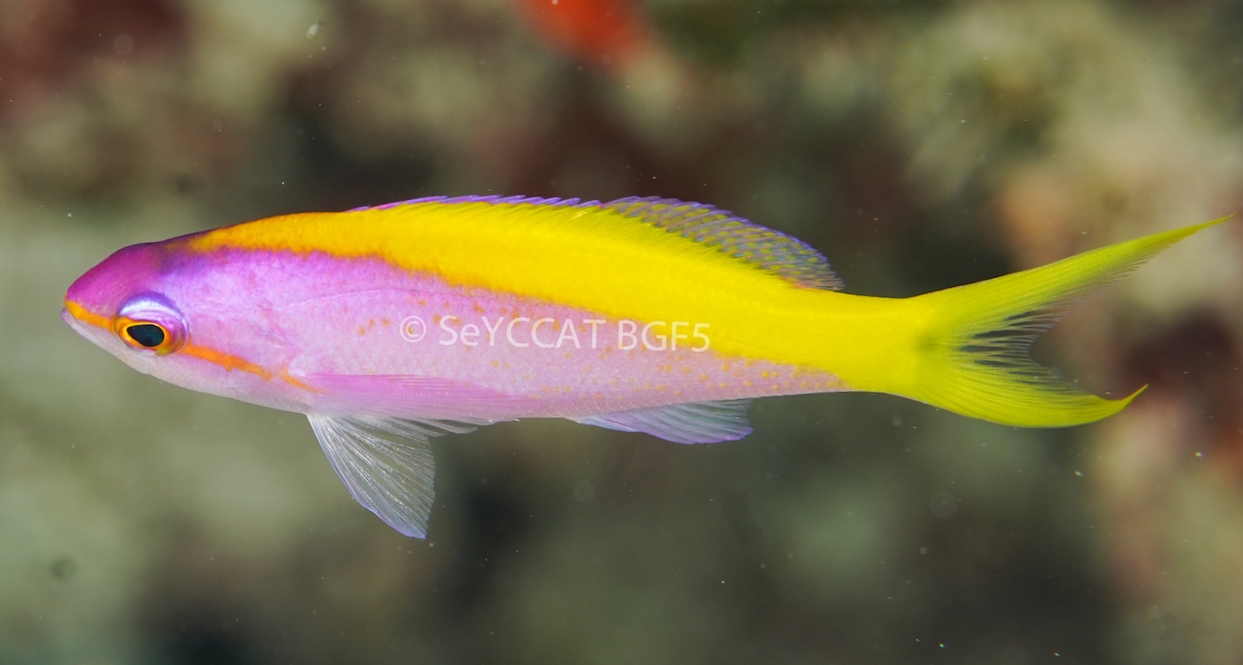Description:
Dorsal spines: 10-11; Dorsal rays: 16-18; Anal spines: 3; Anal rays: 8.
Body robust, but compressed posteriorly. Snout rather sharp, with moderately pointed papilla at apex. Small cutaneous villi about lips and on front of head.
Nostrils fairly wide apart, the posterior larger. Two opercular spines, the upper much the larger, and slightly more posterior. Mouth oblique, lower jaw
shorter, maxilla expanded posteriorly, reaches almost below posterior margin of eye. In upper jaw on the side an outer series of inwardly curved sharp
conical teeth, 2-3 series of much smaller similar teeth in a band within. These end well before the symphysis at a large projecting curved canine or a
pair, on each side. In the lower jaw posteriorly there is a double row of fine conical teeth which becomes single half-way along the mandible, ending well
before the symphysis at a large recurved canine. Scales fairly small, ctenoid, with abundant smaller auxiliary scales. Above the lateral line the rows run
parallel with the dorsal profile, but below are almost horizontal. The whole head, except the lips, is scaly, mostly ctenoid. The whole dorsal fin
is basally scaly, and also the anal and pectoral fins, the scales being elongate oval, but ctenoid. The caudal fin is scaly almost to the apex, and there
are highly elongated scales on the pelvics. Dorsal fin originates immediately behind head. First spine small, graduate larger to the fourth, thereafter
subequal to the last. Rays longer than spines. Anal inserted below the base of the fourth soft dorsal ray, almost exactly midway between caudal base and
hind margin of head. Caudal fin deeply lunate, the lobes produced the upper being longer.
Colour. Body mainly cerise-pink, lighter below, with brilliant yellow spots half diameter of pupil from behind head. Bright yellow From the dorsal
origin and much of the back above the lateral line, broadening posteriorly, and finally including the full width of the peduncle and the whole
caudal fin, save the upper and lower margins. The head is divided into three colour-zones, above pupil level the same cerise as the body, from the tip of
the snout is an oblique orange bar, half pupil width, that runs to the eye, then back and slightly down over the opercle to the pectoral base, where it
ends as a spot of the same diameter. Below this bar the head is pink, the apex of the lips of each jaw scarlet. The iris has a brilliant orange rim round
pupil, but is mainly cerise-pink, with blue dorsally. The dorsal fin yellow with cerise-pink margin. The anal fin is basally pink, the distal submarginal
third yellow, the spines and outer margin pink. The pectoral fins are cerise-pink. The front margin of the pelvic fins is cerise, the first ray yellow,
the rest pink.
Size:
Maturity: Unknown. Max length : 12.0 cm SL.
Habitat and Ecology:
Inhabits outer-reef lagoons and the upper parts of reef drop-offs (depth 4-40 m, usually 10-35 m). Large schools feed on zooplankton above the reef.
Fishery Status:
This species is not protected or subject to fishery regulations.
Notes:
Photo courtesy Eleanor Brighton and Chris Mason-Parker (c) 2022 Blue Safari Seychelles/Marine Conservation Society, Seychelles.
Photograph taken at Alphonse group 2022.
Differs from all other species of this genus in the combination of unique coloration, shape of median fins and scaling.
References:
Bray, D.J. (2023). Mirolabrichthys evansi in Fishes of Australia. https://fishesofaustralia.net.au/home/species/5115 (31/10/23).
Froese, R. & D. Pauly. Eds. (2023). FishBase. Mirolabrichthys evansi. https://www.fishbase.se/summary/pseudanthias-evansi (31/10/23).
Smith, J.L.B. (1954). Two Interesting New Anthiid Fishes from East Africa. The Annals and Magazine of Natural History (12th Series) No. 73. January 1954.
Smith-Vaniz, W.F. et al. (2018). Pseudanthias evansi. The IUCN Red List 2018: https://dx.doi.org/10.2305/IUCN.UK.2018-2.RLTS.T117016784A117017184.en. (31/10/23).
World Register of Marine Species (2023). Pseudanthias evansi (Smith, 1954). https://www.marinespecies.org/aphia.php?p=taxdetails&id=218281 (31/10/23).
Citation:
Nevill, J.E.G., Brighton, E. & Mason-Parker, C. (2023). Pseudanthias evansi, Yellowback anthias. Seychelles Seatizens. www.seatizens.sc. https://seatizens.sc/species/pseudanthias-evansi-smith-1954/


There are no comments